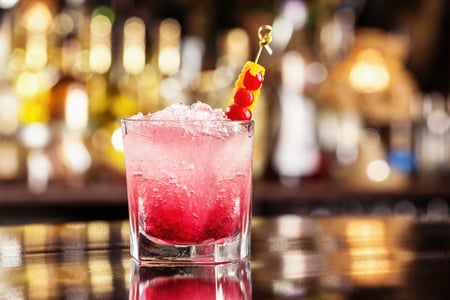Can you have a successful cocktail bar with no — or less — alcohol? It’s an experiment that’s increasingly seeing success.
IWSR Drinks Market Analysis forecasts that in 10 core global markets, the compound annual growth rate in no- and low-alcohol volume will rise by more than 8% between 2021 and 2025, outpacing alcohol volume growth.
What’s driving this sustained interest in no-and-low drinks? It’s not strict teetotaling; rather, “moderation is the most common reason for the consumption of no-and-low products,” The Spirits Business reports. About 43% of adults in IWSR’s survey said they used no-and-low drinks as substitutes for alcoholic drinks for certain occasions, rather than abstaining altogether.
Thinking about starting an alcohol-free cocktail program?
First, test the waters. Begin with a pop-up model, so you can gauge local interest. Austin, Texas-based Sans Bar, one of the pioneers in the nonalcoholic cocktail bar movement, offers a 10-week academy to teach the marketing and mixology principles, culminating with a pop-up launch.
Be inclusive. Nonalcoholic cocktails are for everyone. “We are sober curious. We are sober sometimes. We are in recovery. We are allies of those who abstain for whatever reason. This movement is about so much more than curated depictions of what it means to be alcohol-free,” says Sans Bar founder Chris Marshall.
Offer a tasting menu. This is a sure way to keep things simple, increase revenue and intrigue guests. Suckerpunch, an alcohol-free popup speakeasy in Portland, Oregon, serves a tasting menu with three zero-proof cocktails and bar snacks for $40 per person and a 22% service charge.
Complexity is key. Alcohol-free cocktails should be interesting, not sickly sweet or hastily thrown together. Suckerpunch’s “Straight From The Fire” is made with roasted corn tea, Lyre’s Italian Orange, sarsaparilla, smoked maple syrup, saba, fresh sage, bitters, smoked salt, and orange peel.
Keep costs in mind. Zero-proof spirits aren’t any cheaper than alcoholic spirits, and can be pricier because they’re difficult to make. “Unlike ethanol in alcohol which helps extract and retain the flavors and textures of aromatics or ingredients used during the distillation process, non-alcoholic spirit producers must replicate this process without ethanol in order to hold onto these flavors and textures,” Eater Atlanta explains. The shelf life of nonalcoholic spirits is shorter too.
Consider crafting your own. To cut costs and make more memorable drinks, your bartenders can try concocting housemade non-alcoholic cocktails. “The same principle behind the Golden Ratio (2 parts spirit, 1 part sweet, 1 part sour) also works for nonalcoholic drinks, while substituting the spirit for sparkling water or other zero-proof ingredient,” Wine Enthusiast says. Tea is a key ingredient, adding the astringent, bitter and even smoky notes usually supplied by spirits. The PrimaVac™ line of vacuum packaging machines can add some magic to your mocktails by rapidly infusing simple syrups with fresh herbs, fruit or spices.
Opting for low-alcohol options
Maybe your customer base isn’t ready to give up alcohol, but instead is interested in lighter, less boozy drinks. Low-ABV drinks have proved to be a lasting trend, and the array of options is growing.
Piquette is a dry, fizzy drink made from pomace (what’s left over after a wine is pressed). It also has a sustainable shine, because it reduces winemaking waste. Aperitifs continue to be popular, both classic Italian and French brands like Campari and Lillet Blanc and newer offerings, such as Don Ciccio and Figli's Ambrosia. This aperitivo, flavored with blood orange, cantaloupe and turmeric, is “an absolute game-changer,” according to Deke Dunne, bar supervisor at Allegory at the Eaton Hotel in D.C.
Here's another idea: Serve “reverse” cocktails. Invert the proportions of high- and low-ABV ingredients, like a Manhattan with more vermouth and less whiskey or a martini that’s light on the gin. All the flavor, no headache in the morning.
Commercial blenders and beverage solutions from Hamilton Beach Commercial are built for speed and made to last. See our full line of equipment for bars and cafés.


